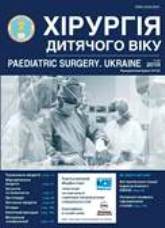Mini-invasive surgery on the lower urinary tract for neuromuscular bladder dysfunction in children
DOI:
https://doi.org/10.15574/PS.2018.60.80Keywords:
neuromuscular dysfunction of the bladder, periurethral injection of bulking agents, childrenAbstract
Introduction. The problem of urinary incontinence in neuromuscular dysfunction of the bladder is quite serious considering the significant medical and social aspects. That is why an active search for methods of urinary continence, including those minimized operational trauma in childhood along with the achievement of maximum efficiency, is being conducted. Special attention should be given to the bladder neck reconstruction methods. When choosing a method for surgical treatment of urinary incontinence with underlying neurogenic bladder dysfunction in children, the degree of bladder innervation damage must be considered. One of the minimally invasive techniques used for urinary incontinence treatment is periurethral injections of bulking agents. However, according to the research literature, this method is rather ineffective (about 30%) and makes it difficult to use the alternative bladder neck reconstruction methods in the future.
Objective: to study the safety and efficiency of the use of such minimally invasive surgical interventions on the bladder neck as periurethral injection of bulking agents in the treatment for the neuromuscular bladder dysfunction in children.
Materials and methods. The first outcome of the minimally invasive surgical interventions, namely periurethral injections of bulk agents, in the treatment for urinary incontinence secondary to neuromuscular bladder dysfunction was analysed in 5 children who were treated at Surgical Department No. 2 of Zhytomyr Regional Children's Clinical Hospital. In total 6 surgical interventions (one child was operated twice) were performed.
Results. As a bulking agent injected periurethraly, polyacryamide hydrogel was used. The mean volume of injected bulking agent was 1.87±0.15 ml. It was found that 1 (20%) patients had dry periods between urination, 2 (40%) had urinary continence during one hour after urination and there were no clinically significant signs of urinary continence in 2 (40%) patients. Any complications after the usage of the specified method were not observed.
Conclusions. Minimally invasive surgical interventions can be used for neuromuscular dysfunction of the bladder in children. However, the indications for the procedure should be highly individualised, taking into account the features and nature of urinary incontinence associated with bladder dysfunction. The disappointing outcomes of the bulking agents usage for periurethral injections in childhood should encourage researchers to search for new efficient nontraumatic methods for treating neuromuscular dysfunction of the bladder.
References
Osipov IB, Hachatryan VA, Saryichev SA, Elikbaev GM. (2008). Diagnostika i lechenie mielodisplazii u detey s urologicheskimi oslozhneniyami. Pediatriya zhene bala hirurgiyasyi. 1: 14–17.
Baka-Jabubiak M. (2000). Combined bladder neck, urethral and penile reconstruction in boys with the exstrophy-epispadias complex. BJU Int. 86; 4: 513–518. https://doi.org/10.1046/j.1464-410X.2000.00866.x
Block CA, Cooper CS, Hawtrey CE. (2003). Long-term efficacy of periurethral collagen injection for the treatment of urinary incontinence secondary to myelomeningocele. J Urol. 169(1): 327-9. https://doi.org/10.1016/S0022-5347(05)64118-3; https://doi.org/10.1097/00005392-200301000-00098; PMid:12478183
Chernoff A, Horowitz M, Combs A, Libretti D, Nitti V, Glassberg KI. (1997). Periurethral collagen injection for the treatment of urinary incontinence in children. J Urol. 157(6): 2303–5. https://doi.org/10.1016/S0022-5347(01)64769-4; https://doi.org/10.1097/00005392-199706000-00102; PMid:9146659
DaJusta D, Gargollo P, Snodgrass W. (2013). Dextranomer/hyaluronic acid bladder neck injection for persistent outlet incompetency after sling procedures in children with neurogenic urinary incontinence. Journal of Pediatric Urology. 9(3): 278–282. https://doi.org/10.1016/j.jpurol.2012.03.013; PMid:22560990
De Jong TPVM, Chrzan R, Klijn AJ, Dik P. (2008). Treatment of the neurogenic bladder in spina bifida. Pediatr Nephrol. 23: 889–896. https://doi.org/10.1007/s00467-008-0780-7; PMid:18350321 PMCid:PMC2335291
Goldman HB, Sievert K-D, Damaser MS. (2012). Will We Ever Use Stem Cells for the Treatment of SUI? ICI-RS 2011. Neurourol Urodyn. 31(3): 386–389. https://doi.org/10.1002/nau.22217.
Kassouf W, Capolicchio G, Berardinucci G, Corcos J. (2001). Collagen injection for treatment of urinary incontinence in children. J Urol. 165(5): 1666–8. https://doi.org/10.1016/S0022-5347(05)66387-2; https://doi.org/10.1097/00005392-200105000-00074; PMid:11342951
Snodgrass W, Villanueva C, Gargolo P, Jacobs M. (2014). New hydronephrosis and/or vesicoureteral reflux after bladder outlet surgery without augmentation in 75 children with neurogenic bladder. Journal of Pediatric Urology. 10; 5:906–910. https://doi.org/10.1016/j.jpurol.2014.02.005; PMid:24680474
Surer I, Baker LA, Jeffs RD, Gearhart JP (2001). Combined bladder neck reconstruction and epispadias repair for exstrophyeispadias complex. J urol. 165: 2425–7. https://doi.org/10.1097/00005392-200106001-00052; https://doi.org/10.1016/S0022-5347(05)66220-9
Downloads
Issue
Section
License
The policy of the Journal “PAEDIATRIC SURGERY. UKRAINE” is compatible with the vast majority of funders' of open access and self-archiving policies. The journal provides immediate open access route being convinced that everyone – not only scientists - can benefit from research results, and publishes articles exclusively under open access distribution, with a Creative Commons Attribution-Noncommercial 4.0 international license(СС BY-NC).
Authors transfer the copyright to the Journal “PAEDIATRIC SURGERY.UKRAINE” when the manuscript is accepted for publication. Authors declare that this manuscript has not been published nor is under simultaneous consideration for publication elsewhere. After publication, the articles become freely available on-line to the public.
Readers have the right to use, distribute, and reproduce articles in any medium, provided the articles and the journal are properly cited.
The use of published materials for commercial purposes is strongly prohibited.

